Webserver Mainframes
In conclusion, there are a wide variety of hardware components to any eBusiness solution. The next lesson demonstrates how to assess these hardware elements when choosing them for your solution. The following paragraph describes the different categories of hardware.
| Lesson 2 | Hardware |
| Objective | Identify the function of hardware. |
Identify the Function of Hardware
Hardware, along with the network, provides the physical platform for eBusiness solutions. The term hardware[1] refers to objects that you can actually touch, like disks, disk drives, display screens, keyboards, printers, boards, chips, and multimedia devices.
One is useless without the other. The hardware design specifies the commands it can follow, and the instructions tell it what to do.
Hardware Categories
There are four categories of hardware:
When looking at changes that e-business and commerce make one of the biggest areas where we need new science and thinking is when we consider how people work now and in the future. A decoupling has evolved between where people work and the physical location of where they carry out their work. With domestic broadband, intranet/extranets and email, many people work at home or at a chosen location that is not the traditional workplace. The cost of arranging a virtual meeting with the special hardware involved to allow for video conferencing were high, but now we can do it with equipment bought from a high street outlet and using internet video conferencing for very little actual cost. The freedom and the comfort this affords are incentives for the worker, the cutting of costs and the move to shorter contracts are incentives for the employer. We will explore each of these categories as they relate to eBusiness in the following series of images.
- Servers
- Personal Computers (PCs)
- Handheld devices
- Peripherals
When looking at changes that e-business and commerce make one of the biggest areas where we need new science and thinking is when we consider how people work now and in the future. A decoupling has evolved between where people work and the physical location of where they carry out their work. With domestic broadband, intranet/extranets and email, many people work at home or at a chosen location that is not the traditional workplace. The cost of arranging a virtual meeting with the special hardware involved to allow for video conferencing were high, but now we can do it with equipment bought from a high street outlet and using internet video conferencing for very little actual cost. The freedom and the comfort this affords are incentives for the worker, the cutting of costs and the move to shorter contracts are incentives for the employer. We will explore each of these categories as they relate to eBusiness in the following series of images.
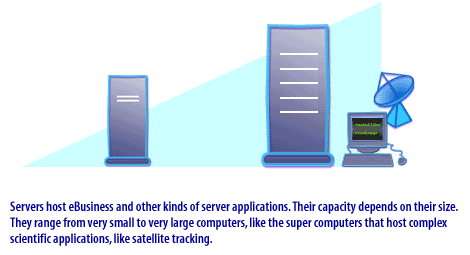
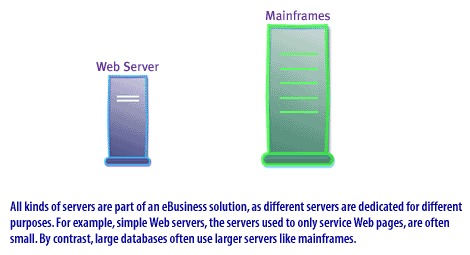
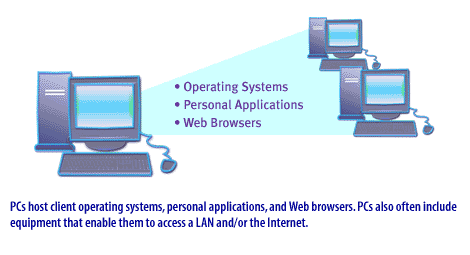
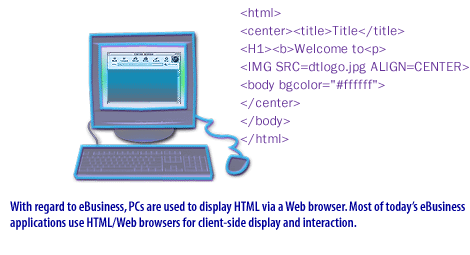
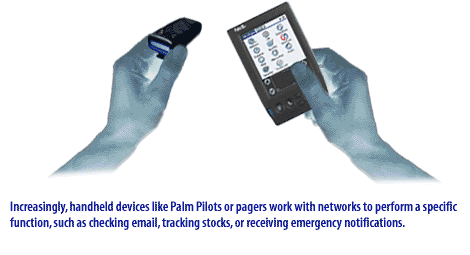
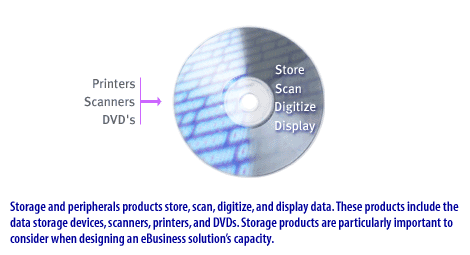
Hardware Components
- Servers: Host eBusiness and other kinds of server applications
- PCs: Host client operating systems, personal applications, and Web browsers
- Handheld devices: Work with networks to perform a specific function, such as checking email
- Storage products and peripherals: Store, scan, digitize, and display data
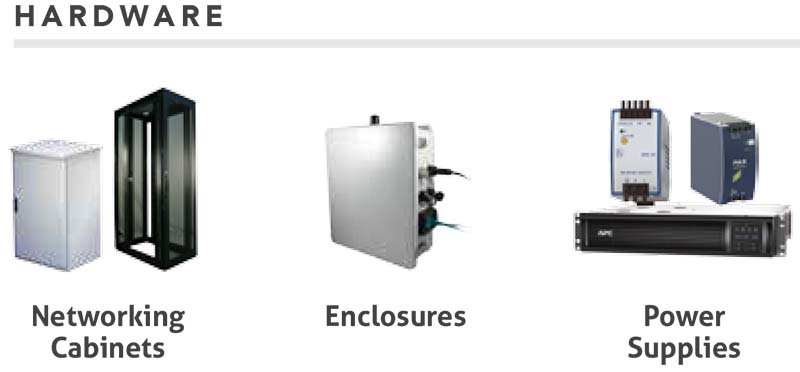
Basic Computer Hardware
Every part of your computer is the result of years of research and development. Parts that were once hand made at a cost of thousands of man-hours are now mass produced for a fraction of a dollar. Computer parts can be divided into two groups, hardware and software.
Computer hardware are the physical parts or components of a computer, such as the central processing unit, monitor, keyboard, computer data storage, graphic card, sound card and motherboard. Software consists of instructions that can be stored and ran by hardware. Software is aset of electronic instructions consisting of complex codes (Programs) that make thecomputer perform tasks. Windows is an operating system.
Other types of software and applications run on your computer. While there are thousands of parts even in the smallest computers that make up its hardware, you are not required to know them all. You only need to know about basic computer hardware.
Computer hardware are the physical parts or components of a computer, such as the central processing unit, monitor, keyboard, computer data storage, graphic card, sound card and motherboard. Software consists of instructions that can be stored and ran by hardware. Software is aset of electronic instructions consisting of complex codes (Programs) that make thecomputer perform tasks. Windows is an operating system.
Other types of software and applications run on your computer. While there are thousands of parts even in the smallest computers that make up its hardware, you are not required to know them all. You only need to know about basic computer hardware.
[1]Hardware: Machinery and equipment such as CPUs, disks, tapes, modems, and cables. In operation, a computer is both hardware and software.